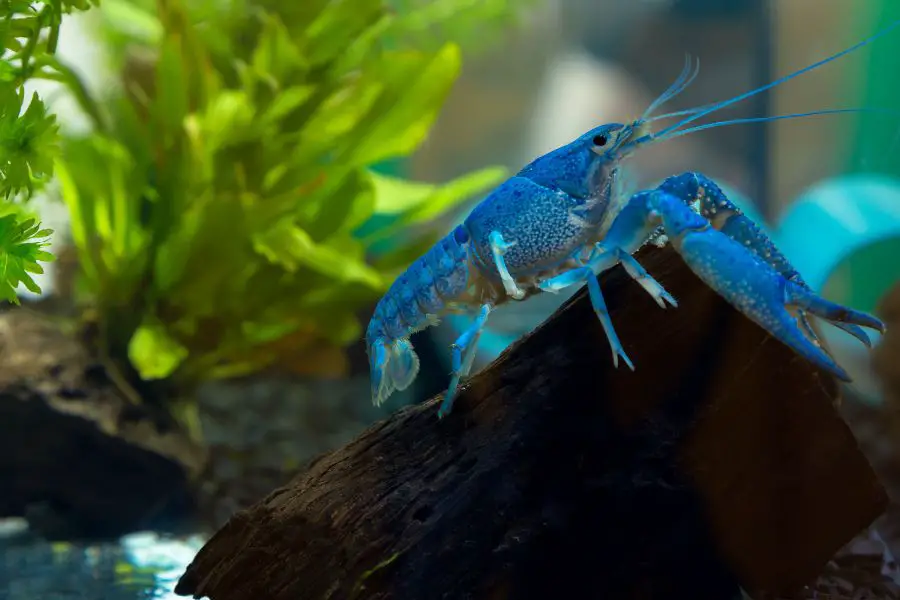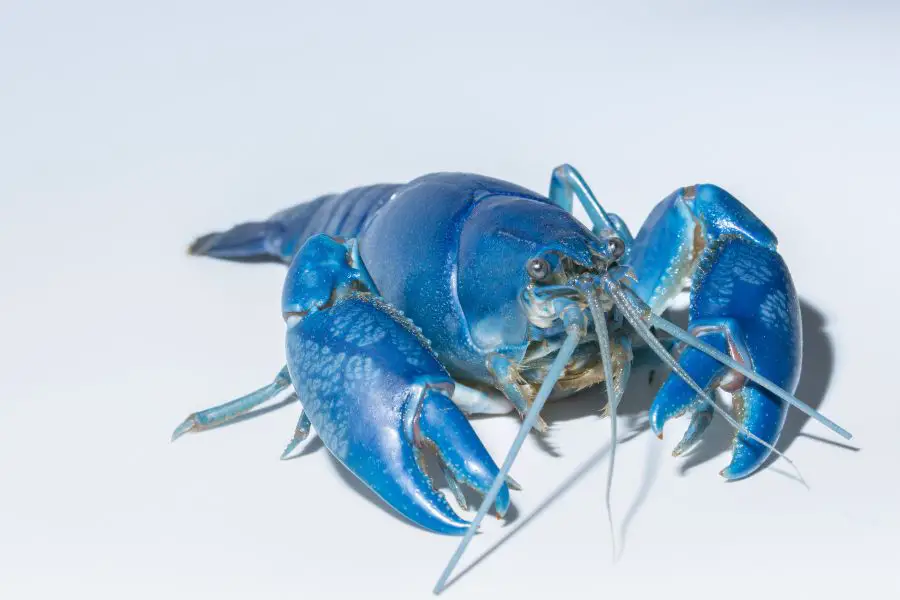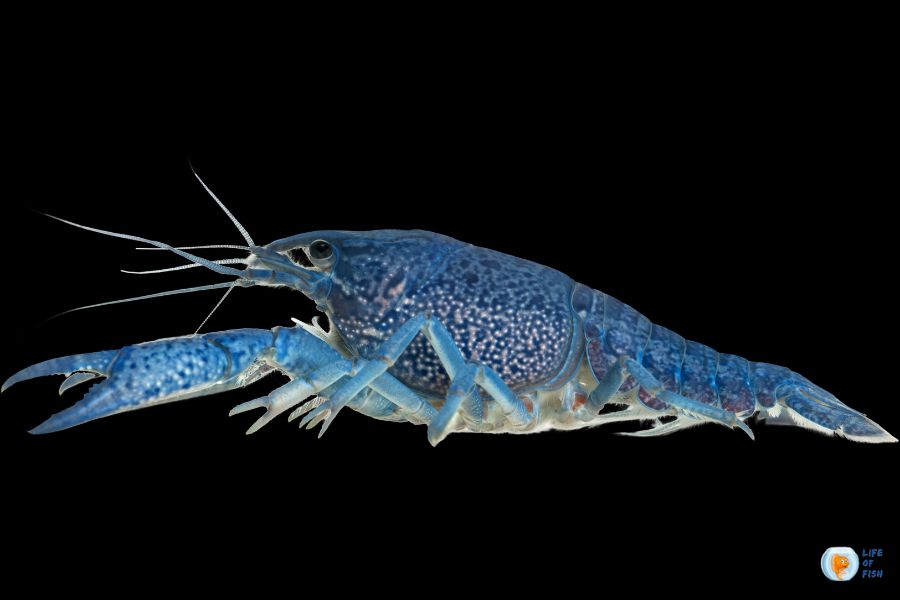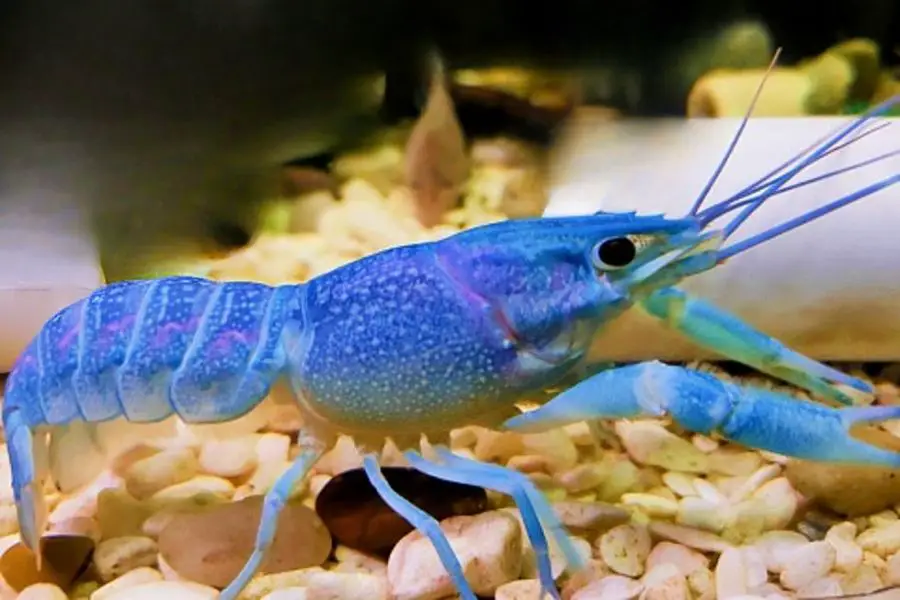With their stunning sapphire colors and feisty personalities, blue crayfish has fast become one of the most popular freshwater species in the aquarium hobby. But keeping these beautiful crustaceans thriving does require some special care and consideration.

This in-depth guide will provide everything you need to know about properly housing, feeding, and breeding these brilliant blue lobsters.
Overview of Blue Crayfish
Jump To
- 1 Overview of Blue Crayfish
- 2 Procuring Your Blue Crayfish
- 3 Housing Blue Crayfish
- 4 Feeding Your Blue Crayfish
- 5 Crayfish Behavior and Handling
- 6 Tankmates for Blue Crayfish
- 7 Breeding Blue Crayfish
- 8 Common Blue Crayfish Health Issues
- 9 Common Blue Crayfish Concerns
- 10 Tips for Keeping Blue Crayfish
- 11 Finding Blue Crayfish for Sale
- 12 Are Blue Crayfish Suitable Pets?
- 13 Conclusion: A Stunning Yet Demanding Species
- Scientific Name: Procambarus alleni
- Common Names: Electric blue crayfish, blue lobster, Florida crayfish, sapphire crayfish
- Native Habitat: Freshwater marshes, streams, and wetlands in Florida and the Southeastern United States.
- Size: 4-5 inches (10-12 cm)
- Lifespan: Up to 5 years with proper care
- Diet: Omnivorous
- Temperament: Very aggressive, cannot be kept with other crayfish
Typical Size
- 4-5 inches (10-12 cm) from rostrum to tail tip
Water Parameters
- Temperature: 68–75°F (20–24°C)
- pH: 7.0-8.0
- gH: 6-12
- kH: 6-10
Diet
- Omnivorous scavengers
- Protein and plant matter
Now that we’ve covered the basics, let’s delve into how to care for these brilliant blue beauties.
Procuring Your Blue Crayfish
Before bringing home any new aquarium inhabitant, make sure you find a good source.
Where to Buy
Purchase blue crayfish from a reputable aquarium store or breeder, not big chain pet stores where they are often housed poorly.
Ask about their origins and look for active, healthy specimens with bright coloration, intact appendages, and no spots or lesions.
Never release non-native crayfish into the wild where they can disrupt local ecosystems.
Acclimating New Crayfish
Always quarantine new crayfish for 2-4 weeks to watch for signs of illness before adding to your display tank.
Use a separate 10 gallon tank with a sponge filter and hiding places. Feed sparingly during this period.
Acclimate blue crayfish slowly to avoid temperature and pH shock. Float the closed bag for 15 minutes to equalize temperatures, then add small amounts of tank water to the bag periodically over several hours before releasing your new crayfish.
Housing Blue Crayfish
Recreating the natural habitat blue crayfish are adapted to will make them feel secure and encourage natural behaviors.
Choosing a Tank
- Minimum 20 gallon tank for one crayfish. Allow 10 extra gallons per additional crayfish.
- Rectangular tanks provide more useful floor space than tall designs.
- Rimless open top tanks require covering to prevent escape.
- Sturdy tank lids are a must as crayfish can easily scale walls and climb out.
Water Parameters
While blue crayfish adapt to a wide range, aim for:
- Temperature between 68–75°F (20–24°C).
- pH between 7.0-8.0.
- gH 6-12.
- kH 6-10.
Use a submersible heater to maintain warm temperatures. Blue crayfish thrive at around 75°F. Cooler water can make them lethargic.
Perform 20-30% partial water changes weekly or biweekly depending on stocking density. Use a gravel vacuum to remove debris.
Filtration
A high-quality canister filter provides the needed biological and mechanical filtration for crayfish waste.
Cover intake tubes with a prefilter sponge to prevent crayfish from entering and getting stuck. Strong water flow can also pin them against filter grates.
Substrate
- Sand or smooth aquarium gravel 0.5-1 inch in diameter.
- Allows burrowing and mimics natural terrain.
- Bare bottom tanks are acceptable but provide less enrichment.
- Larger gravel, pebbles, and crushed coral can damage their sensitive leg joints.
Decorations and Furnishings
In addition to wide open floor space, create sight barriers and hiding spots with:
- Rock caves and crevices
- Driftwood
- Aquarium-safe clay flower pots
- Sections of PVC pipe
Plants will be shredded and eaten, so use only artificial plants and flora.
Lighting
Standard fluorescent or LED aquarium lighting is sufficient. Keep a light cycle of 10-12 hours.
As nocturnal creatures, blue crayfish don’t require intense light. Keep lighting dimmer and provide shaded areas.
Equipment
- Canister Filter and/or Sponge Filter
- Submersible Heater
- LED or Fluorescent Light Fixture
- Clear Acrylic Tank Lid
Performing Water Changes
- Use an aquarium gravel vacuum to siphon waste from the substrate with each partial water change.
- Clean decorations and mechanical filter media in old tank water rather than tap water to preserve beneficial bacteria colonies.
- Avoid sudden water parameter fluctuations by temperature and pH matching new water before refilling the tank.
- Use water conditioner to remove chlorine and chloramines whenever using tap water.

Feeding Your Blue Crayfish
Blue crayfish are omnivorous scavengers that will eat just about anything. Variety is key to a proper diet.
Dietary Needs:
- 40% protein sources
- 40% plant matter
- 10% calcium-rich foods
- 10% commercial foods and supplements
Foods to Offer:
Protein
- Shrimp, krill, crab, clams
- Bloodworms, brine shrimp, daphnia
- Cichlid pellets
- Sinking carnivore pellets or wafers
Plants
- Squash, zucchini
- Spinach, kale, lettuce
- Peas, green beans
- Spirulina algae
Calcium-rich
- Unshelled seafood (shrimp, clam)
- Cuttlebone
- Calcium supplements
Supplements
- Algae wafers
- Sinking bottom feeder pellets
- Vegetable flakes
Feeding Schedule
- Juveniles: Feed 2-3 times per day.
- Adults: Feed once per day.
- Provide only enough food that will get consumed within 2-3 minutes.
- Remove any uneaten portions after a few minutes to avoid fouling the water.
Supplementing Diet
In addition to a varied diet, provide a constant calcium source by placing a cuttlebone in the tank.
Regular calcium intake aids proper molting. Consider freeze-dried krill or shrimp soaked in a vitamin supplement once per week.

Crayfish Behavior and Handling
Blue crayfish display many fascinating behaviors when kept properly. But they can pinch, so exercise caution!
Nocturnal Nature
Blue crayfish are primarily nocturnal and most active at dawn and dusk. During the day they’ll remain hidden if given the opportunity.
Make sure their habitat has plenty of shelters and shaded areas to retreat to.
Burrowing and Rearranging
They constantly dig and rearrange their environment, creating burrows and debris piles that mimic their natural marshland habitats.
A fine sand substrate supports natural burrowing behaviors. Expect them to frequently alter the tank layout.
Aggression and Territoriality
These feisty crayfish are highly aggressive toward their own kind and can inflict serious claw damage.
Never house multiple blue crayfish together unless specifically attempting to breed them. Even then, extreme caution is required.
Provide ample sight breaks, caves, hides, and room to establish distinct territories if housing more than one.
Molting
Like all crustaceans, blue crayfish must periodically shed their outer shell to accommodate growth. This process is called molting or ecdysis.
Their color may appear dull immediately after molting. Avoid handling them during this vulnerable time when the new shell is still soft.
Handling Blue Crayfish
These crayfish have strong claws and can move very fast. Exercise extreme care when handling:
- Never grab a crayfish by the tail or limbs, which can tear off.
- Scoop gently with a net or allow them to walk into a cupped hand.
- Avoid grabbing from above, which can spook them.
- Grip the back of their smooth carapace to restrain claw movement if necessary.
- Expect them to pinch defensively if restrained. Wear gloves and take precautions against claws.
Tankmates for Blue Crayfish
Finding suitable tankmates for aggressive blue crayfish can be challenging. Here are some possibilities:
Fish Tankmates
Larger, fast-moving schooling fish that occupy mid-to-upper levels may fare best with blue crayfish, for example:
- Barb species like tiger barbs
- Larger tetras
- Danios
- Rainbowfish
- Guppies
Slow, bottom-dwelling species are less likely to evade those formidable claws.
Never keep blue crayfish with slow or docile species like bettas, fancy guppies, or angelfish.
Invertebrate Tankmates
Shrimp and snails inevitably become expensive blue crayfish food. Even large nerite snails are at risk of being picked off.
If attempting tankmates, go with faster moving shrimp varieties like:
- Amano shrimp
- Ghost shrimp
- Vampire shrimp
However, recognize that losses may still occur.
General Compatibility Tips
- Heavily plant the middle and upper levels to create barriers.
- Use tall plants like valisneria to break sight lines.
- Arrange caves and hides to establish distinct territories.
- Never house with slow, delicate, or long-finned species.
- Add peaceful tankmates first and crayfish last to reduce aggression.
- Have backup housing available in case conflicts arise.
In truth, blue crayfish thrive best in a species only setup. Their predatory nature makes cohabitating very tricky.

Breeding Blue Crayfish
If you’re up for a challenge, breeding blue crayfish can be an extremely rewarding endeavor. Success requires planning and diligence.
Setting Up the Breeding Tank
- Use at least a 20 gallon tank with plentiful hiding spots.
- Sand substrate supports burrowing and hatchling survival.
- Maintain slightly warmer temperatures of 74-78°F.
- Perform frequent partial water changes to keep parameters pristine.
- Add calcium supplements to support molting and offspring development.
Obtaining a Breeding Pair
- 1 confirmed male and 1 confirmed female are needed. Two males or females will fight relentlessly.
- Males have larger claws and narrower tails while females exhibit smaller claws and wider tails.
- Introduce the pair simultaneously into the prepared breeding tank.
Mating Process
- The male will deposit spermatophores directly onto the female’s underside when she is receptive.
- A berried female with fertilized eggs will retreat to isolation while the eggs incubate.
- Isolate the berried female in a separate 10 gallon nursery tank. Removing her prompts hatching.
- After several weeks, tiny crayfish emerge. They’ll attach to mom’s tail for 1-2 weeks.
Caring for the Baby Crayfish
- Once detached from mom, move female back to breeding tank.
- Leave babies in nursery tank. Provide ample hiding spots and crushed foods.
- Monitor water quality diligently. Perform frequent partial water changes and gravel siphoning.
- As they grow, move juveniles into larger tanks to control cannibalism.
Supplies Needed
- 20 gallon breeding tank
- 10 gallon nursery tank
- Submersible heater
- Sponge filter
- Calcium supplements
- Hiding places like pipe, rocks, driftwood
- Fine gravel or sand substrate
Common Blue Crayfish Health Issues
When cared for correctly, blue crayfish are quite hardy. But here are potential problems to watch for:
Molting Issues
Failing to fully shed their exoskeleton can be fatal. Ensure proper calcium levels and soft water.
Missing Limbs
Lost claws and legs will regenerate at the next molt. Make sure tankmates can’t nip at them.
White Spots
These can indicate bacterial infections. Quarantine and treat with appropriate medications if they appear.
Cannibalism
Missing crayfish likely fell victim to their tankmates. Reduce aggression with adequate space.
Clawing Tankmates
Move afflicted fish to recovery tanks. Try rearranging décor to break up territories.
Escaping the Tank
These adept escape artists will perish quickly if they breach the tank. Use secure lids with no gaps.
Lethargy
Inactivity and loss of appetite can stem from low oxygen, poor water quality, illness, or impending molts. Make adjustments accordingly.
Common Blue Crayfish Concerns
Here are some common issues blue crayfish owners may encounter:
Escaping from the Tank
These expert climbers will make a break for it if given any opportunity. Be sure the tank has a very snug fitting lid with no gaps.
Aggression Toward Tankmates
Crayfish see anything that moves as food. Tankmates should be fast swimming fish that stay out of claw’s reach.
Damaging Live Plants
Blue crayfish will shred and eat any live plants in the tank. Only use artificial plants as decor.
Failed Molts
An inability to shed the old exoskeleton is usually caused by low calcium levels. Supplement their diet and water with calcium.
Claw Loss
Crayfish regenerate lost claws after molting. But if a crayfish loses both claws, it cannot feed itself and will need assistance.
Changes in Color
Bright blue hues may fade temporarily after molting. Colors will intensify again within a few weeks as the new exoskeleton hardens.
Tips for Keeping Blue Crayfish
Follow these best practices for successfully keeping blue crayfish:
- Quarantine new specimens separately for 4 weeks before introducing.
- Perform partial water changes at least weekly to maintain pristine water quality.
- Test pH weekly and temperature daily to catch fluctuations quickly.
- Feed a variety of protein, plants, calcium sources, and supplements.
- Closely monitor interactions with tankmates and separate if issues arise.
- Provide ample hides yet open floor space for burrowing and foraging.
- Use smooth gravel or sand substrate for burrowing and secure footing.
- Maintain consistent warm temperatures around 75°F for optimal health.
- Supplement their diet with calcium-rich foods and a cuttlebone.
Finding Blue Crayfish for Sale
Looking to add some shocking blue crayfish to your freshwater tank? Here are some top options:
Local Fish Stores
Check independent aquarium stores for a selection of color morphs. Inspect carefully for healthy specimens.
Online Retailers
Many online sites offer overnight shipping for live crayfish, but quality may vary:
- LiveAquaria.com
- AquaHuna.com
- ImperialTropicals.com
Read reviews carefully before ordering delicate live animals online.
Local Breeders
Search for crayfish breeders in your state through aquarium clubs and online forums. Local breeds are acclimated.
Ask to see the breeding setups and parents. Well-cared for offspring tend to be heartier.
Aquarium Swaps
Connect with the crayfish keeping community online or through local aquarium societies.
Members often trade entre species like electric blue crayfish at monthly club swaps.
Are Blue Crayfish Suitable Pets?
Electric blue crayfish can make mesmerizing aquarium pets, but they do require special care and housing considerations.
The Good
- Brilliant blue coloring
- Fun antics and behaviors
- Easy to breed
- Adaptable to a range of water parameters
The Bad
- Very aggressive, even toward each other
- Need species-only tank
- Eat or shred tank plants
- Advanced escaping abilities
Best For
- Experienced aquarists
- Species-only tank settings
- Fishkeepers wanting a challenge
- Those appreciating wild behaviors
Conclusion: A Stunning Yet Demanding Species
With their dazzling sapphire hues and lively antics, blue crayfish can be the crown jewels of freshwater tanks when set up properly. Yet their aggressive tendencies and burrowing behaviors do require some special considerations.
Providing ample space, robust filtration, secure lids, plenty of hides, appropriate tankmates, and a varied omnivorous diet gives blue crayfish their best shot at thriving. Though not suitable for placid community tanks, these striking crustaceans can make captivating solo specimens for seasoned aquarists.
Ready to take on the challenges and rewards of keeping stunning blue crayfish? Be sure to thoroughly prepare their habitat, learn their care needs, and make time to appreciate their stunning colors and intriguing behaviors. With dedication to their demanding requirements, electric blue crayfish can show off a dazzling spectacle of color in your own home aquarium.
Read Next: How Big Of A Tank Does A Goldfish Really Need?
